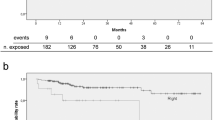Abstract
Background
This prospective, non-randomized, comparative study evaluated morbidity of chemotherapy administration via a totally implantable venous access device (TIVAD) versus peripheral intravenous access (PIVA), and satisfaction in breast cancer patients in a limited-resource setting.
Methods
Consecutive patients receiving chemotherapy via TIVAD (n = 114) or PIVA (n = 159) were studied. Venous access-related events were recorded. Morbidity and satisfaction with TIVAD or PIVA as perceived by the patients were assessed using a specifically designed questionnaire, which patients filled after 1st cycle of, and after completion of all chemotherapy.
Results
Patients in the two groups were of comparable age, body mass index, and disease stage. Acceptance of TIVAD was higher in literate patients. TIVAD did not interfere with sleep or activities in 90 % of patients. The majority (81.2 %) were satisfied with the cosmetic outcome, 91.5 % would have TIVAD re-inserted if the need arose, and 89.6 % would recommend it to others. Non-fatal complications occurred in 16 patients, and TIVAD had to be removed prematurely in five patients. In the PIVA group, 40 % needed multiple needle pricks and 55.8 % developed thrombophlebitis or staining of arms. Drug extravasation and ulceration were suffered by 8.3 and 4.2 %, respectively. However, 78.3 % of patients reported no interference with daily activities and only 26 % would prefer a TIVAD. Those receiving more than six chemotherapy cycles were dissatisfied to a greater extent with PIVA (p < 0.05).
Conclusions
Breast cancer chemotherapy via TIVAD is safe and convenient and results in high satisfaction levels, although it involves additional expenditure. Chemotherapy via PIVA is acceptable, albeit with lower satisfaction, more so in those receiving more than six chemotherapy cycles.



Similar content being viewed by others
References
Niederhuber JE, Ensminger W, Gyves JW et al (1982) Totally implanted venous and arterial access system to replace external catheters in cancer treatment. Surgery 92(4):706–712
Zaghal A, Khalife M, Mukherji D et al (2012) Update on totally implantable venous access devices. Surg Oncol 21(3):207–215
Jan HC, Chou SJ, Chen TH et al (2012) Management and prevention of complications of subcutaneous intravenous infusion port. Surg Oncol 21(1):7–13
Di Carlo I, Pulvirenti E, Mannino M et al (2010) Increased use of percutaneous technique for totally implantable venous access devices. Is it real progress? A 27-year comprehensive review on early complications. Ann Surg Oncol 7(6):1649–1656
Kim JT, Oh TY, Chang WH et al (2012) Clinical review and analysis of complications of totally implantable venous access devices for chemotherapy. Med Oncol 29(2):1361–1364
Bow EJ, Kilpatrick MG, Clinch JJ (1999) Totally implantable venous access ports systems for patients receiving chemotherapy for solid tissue malignancies: a randomized controlled clinical trial examining the safety, efficacy, costs, and impact on quality of life. J Clin Oncol 17(4):1267
Kreis H, Loehberg CR, Lux MP et al (2007) Patients’ attitudes to totally implantable venous access port systems for gynecological or breast malignancies. Eur J Surg Oncol 33(1):39–43
Johansson E, Engervall P, Björvell H et al (2009) Patients’ perceptions of having a central venous catheter or a totally implantable subcutaneous port system: results from a randomised study in acute leukaemia. Support Care Cancer 17(2):137–143
Ignatov A, Hoffman O, Smith B et al (2009) An 11-year retrospective study of totally implanted central venous access ports: complications and patient satisfaction. Eur J Surg Oncol 35(3):241–246
Agarwal G, Pradeep PV, Aggarwal V et al (2007) Spectrum of breast cancer in Asian women. World J Surg 31:1031–1040
Agarwal G, Aggarwal V, Lal P et al (2008) Feasibility study of safe breast conservation in large and locally-advanced breast cancers with use of radio-opaque markers to mark pre-neo adjuvant chemotherapy tumor margins. World J Surg 32(12):2562–2569
Sticca RP, Dewing BD, Harris J et al (2009) Outcomes of surgical and radiologic placed implantable central venous access ports. Am J Surg 198(6):829–833
Borst CG, De Kruif AT, Van Dam FS (1992) Totally implantable venous access ports-the patients’ point of view: a quality control study. Cancer Nurs 15(5):378
Wincent A, Lidén Y, Arnér S (2003) Pain questionnaires in the analysis of long lasting (chronic) pain conditions. Eur J Pain 7(4):311–321
Narducci F, Jean-Laurent M, Baulanger L et al (2011) Totally implantable venous access port systems and risk factors for complications: a one year prospective study in a cancer centre. Eur J Surg Oncol 37:913–918
Goossens GA, Vrebos M, Stas M et al (2005) Central vascular access devices in oncology and hematology considered from a different point of view: how do patients experience their vascular access ports? J Infus Nurs 28(1):61–67
Author information
Authors and Affiliations
Corresponding author
Additional information
Kul Ranjan Singh and Gaurav Agarwal have contributed equally and should be considered joint first authors.
Rights and permissions
About this article
Cite this article
Singh, K.R., Agarwal, G., Nanda, G. et al. Morbidity of Chemotherapy Administration and Satisfaction in Breast Cancer Patients: A Comparative Study of Totally Implantable Venous Access Device (TIVAD) Versus Peripheral Venous Access Usage. World J Surg 38, 1084–1092 (2014). https://doi.org/10.1007/s00268-013-2378-x
Published:
Issue Date:
DOI: https://doi.org/10.1007/s00268-013-2378-x




